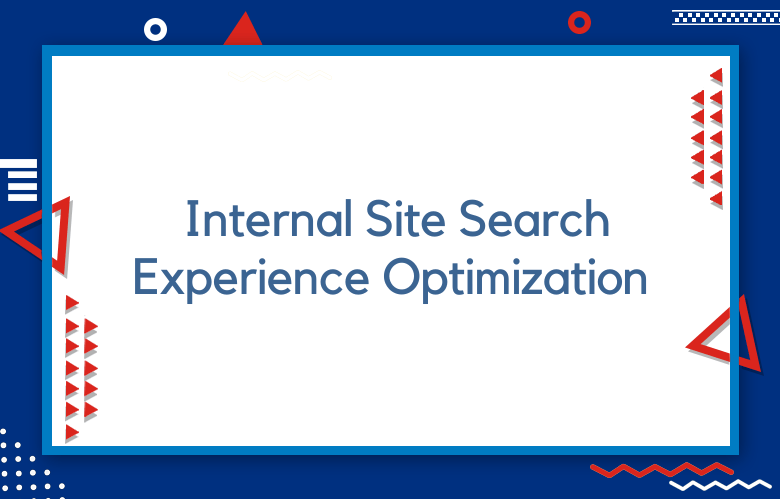What is Internal Site Search Experience Optimization (iSXO)

Internal Site Search Experience Optimization (CXO) is a relatively new concept in website optimization. It refers to optimizing the search experience for users within a particular website or platform.
What is Internal Site Search Experience Optimization (iSXO)?
Here are some critical aspects of ESXi:
-
Search relevance: Optimizing the search algorithm to provide more relevant and accurate search results based on user queries. This includes using natural language processing, machine learning, and other advanced technologies to understand user intent and provide the most relevant results.
-
Search speed: Improving the speed and performance of the search engine to deliver search results quickly and efficiently. This can involve optimizing server performance, reducing query processing time, and using caching techniques to improve search speed.
-
Search suggestions: Providing relevant and helpful search suggestions as the user types in their query. This can include auto-complete functionality, spelling corrections, and synonym suggestions to improve search accuracy and efficiency.
-
Search results presentation: Optimizing the presentation of search results to make it easier for users to find the information they need. This includes visual hierarchy, layout, and categorization to improve the organization and presentation of search results.
-
User feedback and testing: Collecting and analyzing user feedback and using analytics to evaluate the effectiveness of the search experience. This involves continuously testing and refining the search functionality to improve user satisfaction and engagement.
In today’s digital age, users expect a seamless and personalized experience when interacting with websites. A well-designed internal search function can enhance the user experience by providing quick and relevant results, reducing the time and effort required to find the desired information.
CXO involves optimizing various aspects of the internal search function, such as the search interface, algorithm, and result presentation. By doing so, website owners can improve the accuracy and relevance of search results, increase user engagement, and ultimately drive business success.
The process of iSXO typically involves several key steps:
Define the Objectives
The first step in iSXO is to define the objectives of the internal search function. This may include understanding the target audience, the types of information they are seeking, and the desired outcomes of their searches.
Analyze the Current State
The next step is to analyze the internal search function’s current state. This may involve evaluating the search interface, assessing the accuracy and relevance of search results, and identifying areas for improvement.
Optimize the Search Interface
The search interface is the gateway to the internal search function and should be designed to be intuitive and user-friendly. This may involve optimizing the search bar placement, design, and functionality to encourage users to engage with the search function.
Enhance the Search Algorithm
The search algorithm is the backbone of the internal search function and should be designed to deliver accurate and relevant results. This may involve optimizing keyword relevance, user engagement, and content freshness.
Optimize Result Presentation
The presentation of search results is critical to the user experience. Results should be easy to scan, with clear and concise snippets that preview the content.
Measure and Iterate
It is essential to measure the effectiveness of the iSXO efforts and iterate as needed. This may involve tracking key metrics such as search volume, engagement, and conversion rates to assess the impact of optimizations and identify areas for further improvement.
In conclusion, Internal Site Search Experience Optimization is a powerful tool for enhancing the user experience, increasing engagement, and driving business success. By optimizing the various aspects of the internal search function, website owners can provide a seamless and personalized experience that meets the needs and expectations of their target audience.
Mastering the Art of Internal Site Search: An Introduction to CXO
The internal site search function is often overlooked, but it can be a powerful tool for improving the user experience, increasing engagement, and driving business success. Mastering the art of internal site search involves understanding the needs and expectations of the target audience and designing a search function that meets those needs. This is where Internal Site Search Experience Optimization (iSXO) comes in.
CXO is the process of optimizing the various aspects of the internal search function to deliver an exceptional user experience. This includes optimizing the search interface, algorithm, and result presentation to ensure that users can quickly and easily find the information they seek.
Unleashing the Power of Internal Site Search: The Ultimate Guide to iSXO
The internal site search function is a powerful tool that can make or break the user experience. When done right, it can provide a seamless and personalized experience that keeps users engaged and returning for more. However, many websites still struggle to give a practical search function, leaving users frustrated and bouncing off the site. This is where Internal Site Search Experience Optimization (iSXO) comes in.
CXO is the process of optimizing the various components of the internal search function to deliver an exceptional user experience. By understanding the needs and behaviors of their target audience, website owners can design a search function that meets those needs and exceeds expectations.
CXO Demystified: Enhancing Internal Site Search Experience for Better Results
The world of website optimization is vast and complex, with numerous factors to consider to provide an exceptional user experience. One often overlooked element is the internal site search function, which can play a critical role in helping users find the information they need quickly and easily. By mastering the art of Internal Site Search Experience Optimization (iSXO), website owners can enhance the search experience and drive better results.
CXO is the practice of optimizing the various components of the internal search function to deliver accurate, relevant, and engaging results. This includes optimizing the search interface, algorithm, and result presentation to ensure users can find what they want with minimal effort.
The Secret Sauce to Successful Internal Site Search: iSXO Revealed
In the world of website optimization, there are countless factors to consider to provide a seamless and practical user experience. However, one element that is often overlooked is the internal site search function.
A well-designed search function can be the secret sauce to success, providing users with a quick and easy way to find the information they need and increasing the likelihood that they will take the desired action. This chapter will reveal the secret to a successful internal site search: Internal Site Search Experience Optimization (CXO).
CXO is the practice of optimizing the various components of the internal search function to deliver an exceptional user experience. By focusing on the user experience, website owners can increase the likelihood of users engaging with the search function, finding the information they need, and taking the desired action.
Boosting Conversion Rates with iSXO: Optimizing Internal Site Search for Success
Conversion rates are a critical metric for any website, as they indicate the site’s success in turning visitors into customers or achieving other desired outcomes. A well-designed internal site search function can significantly boost conversion rates by helping users find the information they need quickly and easily. This chapter will explore using Internal Site Search Experience Optimization (iSXO) to improve conversion rates and achieve tremendous business success.
To begin, it is essential to understand the current state of the internal search function and its impact on conversion rates. This may involve analyzing data on search volume, engagement, and conversion rates to identify areas for improvement. By understanding the current state of the search function, website owners can prioritize their optimization efforts and target the areas that will have the most significant impact on conversion rates.
From Average to Exceptional: Elevating Your Internal Site Search Experience with CXO
In today’s digital landscape, users expect a seamless and intuitive experience when interacting with websites. An average internal site search function may meet the basic needs of users. Still, an exceptional search experience can distinguish between a visitor leaving the site or taking the desired action. By leveraging the principles of Internal Site Search Experience Optimization (iSXO), website owners can elevate their internal search function and provide an exceptional experience for users.
Website owners should focus on improving the quality of search results to elevate the internal search experience. This may involve optimizing the search algorithm for keyword relevance, user engagement, and fresh content. By delivering more accurate and relevant results, users will be more likely to find the information they need and stay engaged with the site.
Conclusion:
Internal Site Search Experience Optimization (CXO) is a process that involves optimizing the search experience for users within a particular website or platform. This includes optimizing the search interface, algorithm, and result presentation to deliver accurate, relevant, and engaging results.
By focusing on the user experience, iSXO can drive increased engagement, improved conversion rates, and, ultimately, more tremendous business success. As the digital landscape evolves, iSXO will likely become an increasingly important component of any effective website optimization strategy.
Call: +91 9848321284
Email: [email protected]



